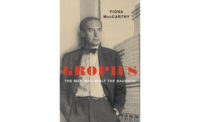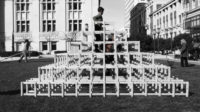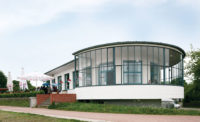With a century of hindsight, the Bauhaus and Harvard seem like an odd coupling; the latter, a then-WASPy bastion of American educational privilege, and the former, a European school hellbent on a revolution in the arts. The nascent Bauhaus even had a quasi-religious tone, as stated in founder Walter Gropius’ manifesto: “We will embrace architecture and sculpture and painting…which will one day rise toward heaven from the hands of a million workers like the crystal symbol of a new faith.”
Prompted by the centennial of the Bauhaus, founded in 1919 in Weimar, Germany, Harvard is opening the doors to its vast Bauhaus collection—the largest outside Germany—with The Bauhaus and Harvard. The enlivening exhibition includes only a fraction of the holdings and is located in the Renzo Piano–designed building addition, now Harvard Art Museums, a consolidation of The Fogg, the Busch-Reisinger, and Arthur M. Sackler museums. The collection was spurred by Gropius, who recognized the historical importance of the Bauhaus artifacts. In 1948, he asked Charles Kuhn, director of the Bausch-Reisinger Museum, to solicit donations from Bauhaus alumni, including pieces from various Bauhaus-influenced schools. The show, well-organized into three sections, encompasses painting, graphics, sculpture, photography, architecture, weaving, and more.
The first section is devoted to material produced at the Bauhaus in Germany with themes like “The Preliminary Course,” showing early student works; “The New Dwelling,” exploring the Bauhaus and architecture; and “Weaving,” highlighting exquisite fabrics, produced mostly by women. (Curator Laura Muir says that “The Bauhaus was progressive, but not quite as much as they imagined, since female students were sometimes relegated to this discipline associated with homemaking.”)
The second section of the exhibition examines the effects of Bauhaus pedagogy in the United States, chiefly at Black Mountain College in North Carolina, Brooklyn College in New York, and Newcomb College (now part of Tulane University) in New Orleans.
Finally, the third section highlights the first modernist building on Harvard’s campus: the Harvard Graduate Center, a dorm and dining facility designed by Gropius, who was head of the architecture department at Harvard’s Graduate School of Design from 1937 to 1952.
Look for small jewels in the exhibition and you won’t be disappointed. Take, for instance, Oskar Schlemmer’s delightful Costume Designs for the Triadic Ballet, a jaunty assemblage of colorful outfits composed mostly of rigid geometrical forms; the exquisite weavings of Anni Albers, in which she channels her husband Josef’s geometric themes while adding a distinctive imprint of her own; and the assemblage of miniature sculptures from the Newcomb College collection, created between 1942 and 1949, and, alas, identified only as “Unknown Artist.”
The exhibition concludes with a full-gallery installation of Hans (Jean) Arp’s Constellations II, commissioned for the Graduate Center but removed for a renovation of the complex. The work has been painstakingly restored, but its drab brown color against the white walls makes it a bit of a letdown after all of the color in the rest of the exhibition.
But this is a minor quibble; if the exhibition has a fault, it’s that it’s too small and leaves one hankering for more. Gropius and his followers may not have created a new religion, but they produced a seductive body of work that never gets old. Harvard is lucky to have its vast Bauhaus trove, and we are lucky that they are sharing it.
The exhibition The Bauhaus and Harvard runs through July 28, 2019, at the Harvard Art Museums.











Post a comment to this article
Report Abusive Comment